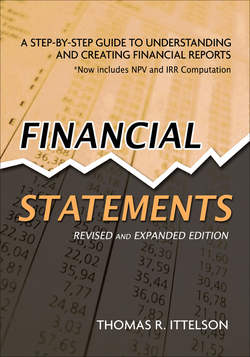Читать книгу Financial Statements - Ittelson Thomas - Страница 5
На сайте Литреса книга снята с продажи.
Introduction
ОглавлениеMany non-financial managers have an accounting phobia …a financial vertigo that limits their effectiveness. If you think “inventory turn” means rotating stock on the shelf, and that “accrual” has something to do with the Wicked Witch of the West, then this book’s for you.
Financial Statements: A Step-by-Step Guide to Understanding and Creating Financial Reports is designed for those business professionals (1) who know very little about accounting and financial statements, but feel they should, and those (2) who need to know a little more, but for whom the normal accounting and financial reporting texts are mysterious and unenlightening. In fact, the above two categories make up the majority of all people in business. You are not alone.
Financial Statements: A Step-by-Step Guide to Understanding and Creating Financial Reports is a transaction-based, business training tool with clarifying, straightforward, real-life examples of how financial statements are built and how they interact to present a true financial picture of the enterprise.
We will not get bogged down in details that get in the way of conceptual understanding. Just as it is not necessary to know how the microchips in your computer work to multiply a few numbers, it’s not necessary to be a Certified Public Accountant (CPA) to have a working knowledge of the “accounting model of the enterprise.”
Transactions. This book describes a sequence of “transactions” of our sample company, AppleSeed Enterprises, Inc., as it goes about making and selling delicious applesauce. We will sell stock to raise money, buy machinery to make our product, and then satisfy our customers by shipping wholesome applesauce. We’ll get paid and we will hope to make a profit. Then we will expand the business.
Each step along the way will generate account “postings” on AppleSeed’s books. We’ll discuss each transaction to get a hands-on feel for how a company’s financial statements are constructed. We’ll learn how to report using the three main financial statements of a business – the
“Accounting is a language, a means of communicating among all the segments of the business community. It assumes a reference base called the accounting model of the enterprise. While other models of the enterprise are possible, this accounting model is the accepted form, and is likely to be for some time.
“If you don’t speak the language of accounting or feel intuitively comfortable with the accounting model, you will be at a severe disadvantage in the business world. Accounting is a fundamental tool of the trade.”
Gordon B. Baty
Entrepreneurship
Prentice Hall, Englewood Cliffs, NJ, 1990
Financial Statements
Balance Sheet, Income Statement and Cash Flow Statement – for these common business dealings:
1. selling stock
2. borrowing money
3. receiving orders
4. shipping goods
5. invoicing customers
6. receiving payments
7. paying sales commissions
8. writing off bad debts
9. prepaying expenses
10. ordering equipment
11. paying deposits
12. receiving raw materials
13. scrapping damaged product
14. paying suppliers
15. booking manufacturing variances
16. depreciating fixed assets
17. valuing inventory
18. hiring staff and paying salary, wages and payroll taxes
19. computing profit
20. paying income taxes
21. issuing dividends
22. acquiring a business
23. and more
By the end of this book, you’ll know your way around the finances of our applesauce-making company, AppleSeed Enterprises, Inc.
Goals. My goal in writing this book is to help people in business master the basics of accounting and financial reporting. This book is especially directed at those managers, scientists and salespeople who should know how a Balance Sheet, Income Statement and Cash Flow Statement work…but don’t.
Your goal is to gain knowledge of accounting and finance to assist you in your business dealings. You want the power that comes from understanding financial manipulations. You must know how the score is kept in business. You recognize, as Gordon Baty says, you must “feel intuitively comfortable with the accounting model” to succeed in business.
This book is divided into five main sections, each with a specific teaching objective:
Section A. Financial Statements: Structure & Vocabular y will introduce the three main financial statements of the enterprise and define the special vocabulary that is necessary to understand the books and to converse with accountants.
Section B. Transactions: Exploits of AppleSeed Enterprises, Inc. will take us through 31 business transactions, showing how to report financial impact of each on the Balance Sheet, Income Statement and Cash Flow Statement of AppleSeed Enterprises.
Section C. Financial Statements: Construction & Analysis will subject the financial statement of our sample company to a rigorous analysis using common ratio analysis techniques. Then finally we will touch on how to “cook the books,” why someone would want to, and how to detect financial fraud.
“…even if it’s boring and dull and soon to be forgotten, continue to learn double-entry bookkeeping. People think I’m joking, but I’m not. You should love the mathematics of business.”
Kenneth H. Olsen
entrepreneurial founder of Digital Equipment Corporation
Section D. Business Expansion: Strategy, Risk & Capital will describe the strategic decisions that a fledgling company must make when it expands. We will answer the questions, “Where will we get the money?” and “How much will it cost?”
Then in Section E. Making Good Capital Investment Decisions we will analyze business expansion alternatives and select the best using sophisticated net present value (NPV) techniques.
With your newly acquired understanding of the structure and flow of money in business, you will appreciate these important business quandaries:
• How an enterprise can be rapidly growing, highly profitable and out of money all at the same time…and why this state of affairs is fairly common.
• Why working capital is so very important and which management actions lead to more, which lead to less.
